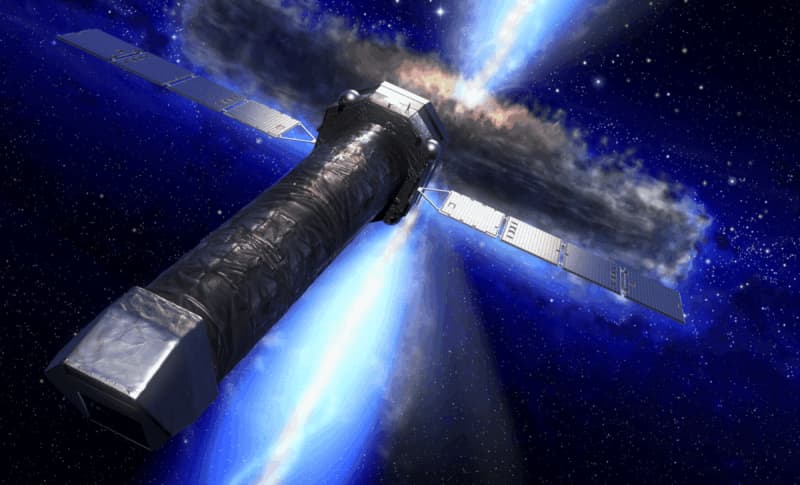
Image credit: ESA | The Daily Galaxy –Great Discoveries Channel
In the quest to uncover the mysteries of the universe’s early days, a new astronomical tool is set to revolutionize our understanding of supermassive black holes. Europe’s upcoming**NewAthena telescope **promises to provide insights into these cosmic giants that formed when the universe was still in its infancy. The telescope, which will launch in 2037, has been the subject of a recent study led by Portuguese researchers, with exciting predictions about its capabilities. Published in the Monthly Notices of the Royal Astronomical Society, the research hints at discoveries that could reshape our understandin…

Image credit: ESA | The Daily Galaxy –Great Discoveries Channel
In the quest to uncover the mysteries of the universe’s early days, a new astronomical tool is set to revolutionize our understanding of supermassive black holes. Europe’s upcoming**NewAthena telescope **promises to provide insights into these cosmic giants that formed when the universe was still in its infancy. The telescope, which will launch in 2037, has been the subject of a recent study led by Portuguese researchers, with exciting predictions about its capabilities. Published in the Monthly Notices of the Royal Astronomical Society, the research hints at discoveries that could reshape our understanding of the cosmos.
The Power of NewAthena: A Game-Changer for Astrophysics
The NewAthena space observatory, being developed by the European Space Agency (ESA), represents a major leap forward in our exploration of the universe. While telescopes today have opened our eyes to distant galaxies and black holes, NewAthena’s advanced X-ray technology will allow scientists to peer deeper into the cosmos, reaching back to a time when the universe was only a fraction of its current age. One of its most remarkable capabilities will be its ability to detect supermassive black holes that existed when the universe was still in its early stages. These black holes, which are thought to have formed less than a billion years after the Big Bang, are a crucial part of the puzzle that scientists are trying to solve.
As Nuno Covas, a researcher at the Institute of Astrophysics and Space Sciences (IA) at the University of Lisbon, explains, “With NewAthena, it will be possible to discover around 250,000 active galactic nuclei, which are the black holes that are actively feeding.” This discovery is anticipated to offer a wealth of data about the formation and evolution of black holes, as well as the galaxies that surround them. The telescope’s X-ray observations will provide the clearest and most detailed pictures yet of these distant objects, allowing astronomers to study the physics of these massive forces.

Image
A Bold New Study and Its Implications for the Early Universe
A groundbreaking study, recently published in theMonthly Notices of the Royal Astronomical Society and, forecasts that **NewAthena *could detect black holes from the earliest days of the universe. Researchers, led by Portuguese astrophysicists, have used cosmological simulations to predict how the telescope will capture faint X-rays emitted by matter falling into black holes. As reported byEuroNews*, the findings suggest that NewAthena could uncover up to 250,000 active black holes, some of which are located only a few billion years after the universe’s birth.
José Afonso, another key figure from the University of Lisbon, elaborates on the importance of this work: “We have almost reached that first phase of the universe, where galaxies and black holes begin to appear.” The simulations indicate that NewAthena will be able to observe these black holes in the Epoch of Reionisation, a critical period in cosmic history. This will allow scientists to study the black holes at the heart of the earliest galaxies, which may hold answers to questions about the universe’s beginnings.
Unraveling the Mystery of Black Hole and Galaxy Formatio
One of the most profound questions in modern astrophysics is whether supermassive black holes or galaxies form first. The formation of these cosmic giants is intricately linked, but scientists have struggled to determine which came first. Was it the black hole that formed first, drawing in matter and creating a galaxy around it, or did the galaxy form first, with the black hole emerging later at its core? The NewAthena telescope, with its unparalleled ability to detect black holes from the distant past, could finally help answer this pressing question.
“What we really want is to discover these black holes giving rise to the formation of the first galaxies,” says José Afonso. The upcoming data from NewAthena will likely offer the first detailed glimpse into this process, potentially allowing scientists to determine whether supermassive black holes were the driving force behind the creation of galaxies or if the relationship between them is more complex. As Afonso notes, the current inability to answer this question is “a bit of a game of chicken or the egg.”
NewAthena’s Complementary Role in the Future of Space Observatories
NewAthena will not operate in isolation. Instead, it will complement other groundbreaking space missions, including LISA (Laser Interferometer Space Antenna) and the Square Kilometre Array (SKAO), set to launch in the next decade. These revolutionary observatories will work in tandem, providing a large-field, high-energy view of the universe. Israel Matute, one of the study’s authors, explains that the combination of NewAthena’s X-ray capabilities and the next-generation observatories will allow for unprecedented observations of the universe’s most distant and faintest phenomena.
“The large-field, high-energy view of the universe provided by NewAthena will be an essential complement to the revolutionary observatories of the next decade,” says Matute. This collaboration between different space observatories will help scientists gather comprehensive data on the formation of black holes, galaxies, and other cosmic structures, providing a holistic understanding of the universe’s origins and evolution.
Enjoyed this article? Subscribe to our free newsletter for engaging stories, exclusive content, and the latest news.